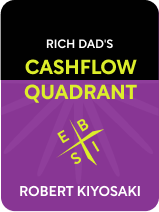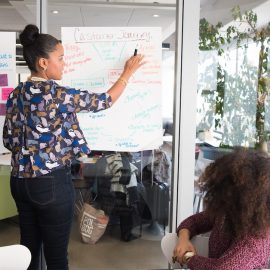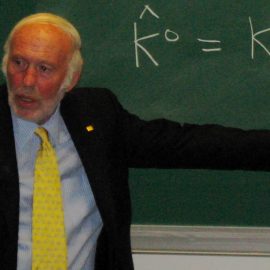

This article is an excerpt from the Shortform book guide to "Rich Dad's Cashflow Quadrant" by Robert T. Kiyosaki. Shortform has the world's best summaries and analyses of books you should be reading.
Like this article? Sign up for a free trial here .
Which cashflow quadrant are you in? Do you generate income from the work you do (E and S quadrants) or from the assets you own (B and I quadrants)? Which quadrant is the most conducive to building wealth?
Robert Kiyosaki uses the concept of the ESBI quadrant to categorize different ways of generating income. The first two quadrants, employees (E) and the self-employed and small business owners (S) are usually dead-ends on the road to wealth. The other two quadrants, big business owners (B) and investors (I), are the most conducive to accumulating wealth because those are the categories in which you can develop passive income in the form of assets.
Here, we’ll go over four major changes you have to make to your thinking to succeed in the wealth quadrants.
B’s and I’s Fundamentally Understand Money
According to Kiyosaki, there are two groups of people: people who understand how money flows and grows, and people who don’t. Those who don’t are usually in the E and S categories. People who are fluent in money 1) realize how important it is to be wealthy and 2) know that the best way to wealth is to be in the B and I categories. If you’re fluent in money, you’re at a big advantage.
(Shortform note: It’s harder, and more important, to be financially literate today than it was in the past. While your grandparents may have made most of their day-to-day purchases in cash and may have had pensions that required very little decision-making, financialization of the U.S. economy has meant saving, investment, and retirement options are now more complicated than they’ve ever been. Between 1950 and 2019, the financial sector’s share of the U.S. GDP rose from about 3% to over 20%.)
B’s and I’s Utilize “Other People’s Money” and “Other People’s Time”
In the E and S categories, you earn money from your work and time. Earners in the B category generate wealth by using other people’s time and people in the I category can make money using other people’s money.
Remember that in the B category, you own a system that can run without you. A B category business owner makes money from the time and labor of the people who work for their business.
In the I category, you can use your own money to invest, but you can also invest with other people’s, or a bank’s, money. (Shortform note: That money will probably come in the form of a loan, which you pay interest on. You’re betting that the profit you can make from the borrowed money will be more than the interest you owe.)
| Three Ways to Use “Other People’s Money” to Start a Business Other people’s money isn’t just for investing. It’s a common way to start a business, too, since most people don’t have enough capital on their own. 1. Borrow from the bank. A line of credit in the form of a credit card can be a good choice because many cards don’t charge interest for the first year, allowing you some time to generate a profit. 2. Apply for grants and awards. Be on the lookout for opportunities to acquire capital you don’t have to pay back. 3. Find an investor. Investors are always looking for great new business ideas—yours could be the one they’ve been waiting for. |
B’s and I’s Ask “Who Am I Making Rich?”
The fundamental question to ask yourself in the B and I categories is: Who are you making rich? In a capitalist economy, Kiyosaki says, either you’re getting rich, or you’re making someone else rich.
In the E and S categories:
- Employees make more money for their employers than themselves.
- People in debt make more money for their banks and credit card companies than themselves.
- Taxpayers make a large chunk of their money for the government.
- Consumers make money for the business they buy from.
In all these scenarios, there’s someone upstream from you profiting from your labor.
In the B and I categories, however:
- Business owners make money for themselves because their labor goes into a company they own.
- Investors make money for themselves because they earn direct profit from their investments, which they own.
If you’re not strategizing your cashflow to primarily benefit you, you’re creating more wealth for someone else than you are for yourself.
B’s and I’s Know That Our Society Rewards Wealth
Kiyosaki argues that the wealthy play by different rules than everyone else. Kiyosaki identifies two ways our society rewards the wealthy for having wealth.
- As we discussed in Part 2, the B and I categories have a more favorable tax situation than the E and S categories. Kiyosaki says that middle-class taxes, often paid by people in the E and S categories, go to tax breaks for the rich, who are more often in the B and I categories.
- Some tax-advantaged investments are only available to the rich. (Shortform note: Kiyosaki doesn’t name specific investments that are only available to the rich, but journalists with access to tax records have found that many of America’s wealthiest investors and business owners (including billionaire and PayPal cofounder Peter Thiel) use the humble Roth IRA, developed to help average Americans increase their savings, as one of their primary tax-advantaged accounts. While it’s true that most people have access to Roth IRAs, not many have access to the stock deals and assets that the rich use these vehicles to invest in.)

———End of Preview———
Like what you just read? Read the rest of the world's best book summary and analysis of Robert T. Kiyosaki's "Rich Dad's Cashflow Quadrant" at Shortform .
Here's what you'll find in our full Rich Dad's Cashflow Quadrant summary :
- Why the traditional path of college to career doesn't work
- Which types of income will lead you to financial freedom
- An in-depth look at Robert Kiyosaki's four cashflow quadrants






